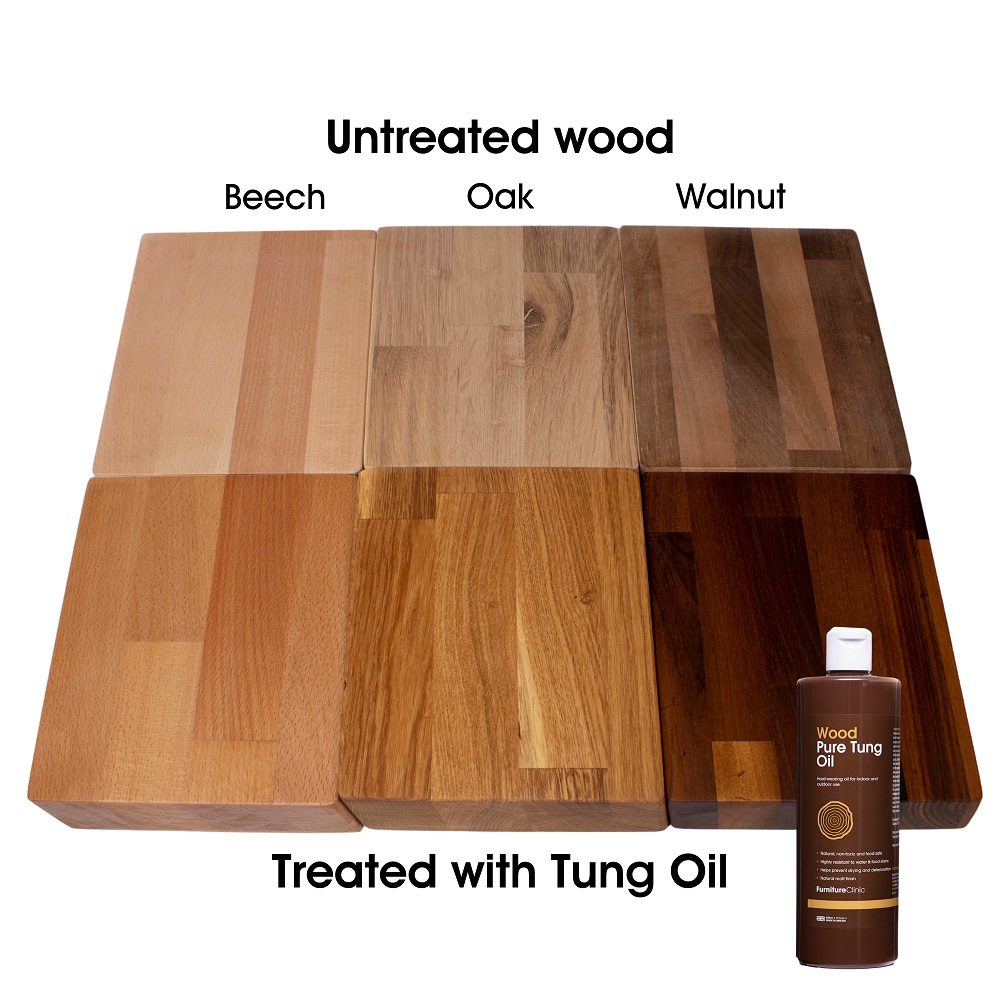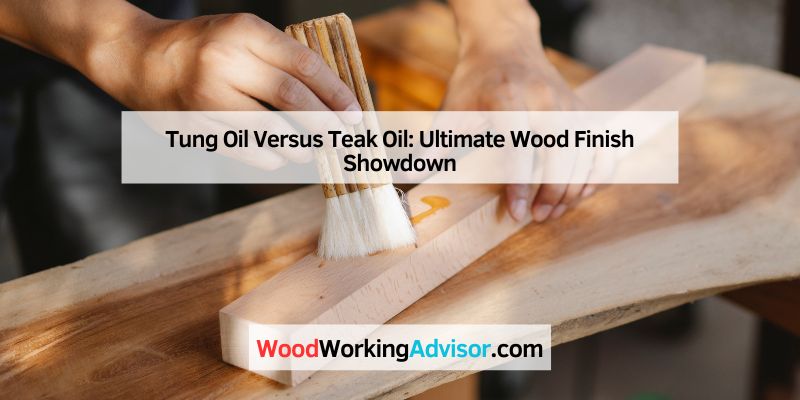When it comes to giving your wooden furniture or outdoor decking a stunning finish, you might find yourself caught in the tug-of-war between tung oil and teak oil. You want your wood to shine with a natural glow and be protected against the elements, but choosing the right oil can make all the difference.
Imagine transforming your beloved pieces into eye-catching treasures that last for years. The secrets behind achieving this lie in understanding the unique qualities and benefits of both tung oil and teak oil. This guide is crafted just for you, unraveling the mysteries behind these popular oils, so you can make the best choice for your woodworking projects.
Discover how each oil can enhance the beauty and durability of your wood, and learn what suits your needs perfectly. Dive in, and unlock the potential to elevate your woodworking skills to new heights!
Tung Oil Basics
Tung oil offers a natural finish, enhancing wood grain with a warm glow. Teak oil, often synthetic, provides a hard, protective layer. Each has unique properties suited for different woodworking needs. Understanding the differences helps in choosing the right oil for your project.
Origins And Production
Tung oil comes from the seeds of the tung tree. This tree grows in China and South America. The seeds are crushed to get the oil. This oil is then cleaned and bottled for use. Tung oil has been used for hundreds of years. It is a natural product.
Properties And Characteristics
Tung oil dries quickly. It makes wood shine. It protects wood from water. It is clear and does not change the wood color. Tung oil is safe for the environment. It does not smell bad. It lasts a long time.
Common Uses
Tung oil is used on furniture. It is good for floors. It is used on boats. Artists use it for paintings. It is great for outdoor wood. It keeps the wood safe from rain. Tung oil is loved by woodworkers.

Teak Oil Essentials
Choosing the right oil for wood care can be tricky. Tung oil offers a durable finish, enhancing grain and resistance. Teak oil, often a blend, provides easy application and fast drying, ideal for outdoor furniture. Each oil has distinct benefits, catering to specific needs and preferences.
Composition And Variants
Teak oil is a blend of oils and varnishes. It often includes linseed oil. Some variants mix tung oil with other ingredients. This enhances its properties. Teak oil is not from the teak tree. It is named for its use on teak wood. Different brands have unique formulas. These provide varied results.
Properties And Characteristics
Teak oil penetrates deeply into wood. It brings out the grain beautifully. It provides a warm, golden finish. Teak oil offers water resistance. It is not entirely waterproof. Regular application is needed for protection. It dries faster than tung oil. The finish is durable and smooth.
Applications In Woodworking
Teak oil is ideal for outdoor furniture. It protects against sun and rain. It is used for decks and boats. Easy to apply with a brush or cloth. It enhances the wood’s natural beauty. It is suitable for indoor furniture too. Maintenance is simple with teak oil.
Comparing Durability
Tung oil offers superior water resistance, making it ideal for outdoor furniture. Teak oil enhances wood grain, providing a warm finish. Both oils protect wood, but tung oil is known for its longer-lasting durability.
Resistance To Moisture
Tung oil provides excellent moisture resistance. It creates a hard finish on wood. This makes it ideal for outdoor use. Teak oil offers good moisture protection too. However, it might not be as strong as tung oil. Teak oil often needs frequent applications. This helps maintain its moisture resistance. Tung oil penetrates deeply. It seals the wood better. Thus, it gives longer-lasting protection against water.
Wear And Tear Performance
Tung oil is known for its strong wear resistance. It forms a durable surface on the wood. Teak oil also protects against wear. Yet, it might need more coats to be effective. Tung oil hardens over time. This enhances its durability. Teak oil provides a nice finish. But it might wear off quicker. Regular reapplication is essential for teak oil users. This keeps the wood looking good and well-protected.
Aesthetic Differences
Tung oil gives a matte finish. It looks soft and natural. Teak oil, on the other hand, provides a glossier finish. It shines more. The choice depends on your style. Do you like a shine or a soft look? Both have their own charm.
Tung oil darkens wood slightly. It adds a warm tone. Teak oil enhances the grain. It brings out the wood’s natural color. Some prefer the subtle change of tung oil. Others enjoy the enhanced grain from teak oil. What do you like more? A subtle change or a vibrant grain?
Application Techniques
Begin by gathering all necessary tools and materials. You will need a soft cloth, sandpaper, and a clean brush. Make sure the surface is clean and dry. Sand the wood lightly to smooth any rough areas. Wipe off dust with a damp cloth. Choose a well-ventilated area for working. This helps in drying.
First, pour a small amount of oil into a container. Dip the brush into the oil. Apply the oil in thin, even strokes. Cover the whole surface carefully. Let the oil soak in for 20 minutes. Wipe away any excess oil with a clean cloth. Allow the surface to dry for 24 hours. Repeat the process for a deeper finish. Always follow the grain of the wood.

Credit: www.furnitureclinic.co.uk
Environmental Considerations
Tung oil comes from the seeds of the tung tree. This tree grows fast and is easy to farm. This makes tung oil a renewable resource. Teak oil, on the other hand, is often a mix of oils. It may contain ingredients from non-renewable sources. Checking labels is important. Look for oils that are sustainable. This helps the earth and saves trees.
Tung oil is natural and safe for people. It does not have harmful chemicals. Teak oil may have added chemicals. Some of these can be unsafe to breathe. Always use oils in open spaces. This keeps the air clean and safe. Safety first when using any oil.
Cost And Accessibility
Tung oil often costs less than teak oil. This makes it a popular choice. Teak oil can be more expensive. Some people think it’s worth the price. Both oils are great for wood. Each oil has its own benefits. Choose based on your needs and budget.
Tung oil is easy to find in stores. It is also online. Teak oil is also available. But it can be a bit harder to find. Some stores may not carry it. Always check online for more options. Both oils have many sellers.

Credit: www.amazon.com
Choosing The Right Oil
Tung oil works well for indoor wood projects. It gives a natural look. Teak oil suits outdoor projects better. It protects against weather. Think about your wood’s location. Is it inside or outside? Choose based on this important factor.
Tung oil has a matte finish. It feels smooth and silky. Teak oil gives a shiny finish. It looks glossy and bright. Decide on the look you want. Matte or shiny? Both oils offer great protection. Consider your style and project goals.

Credit: www.homedit.com
Frequently Asked Questions
Is Teak Oil Or Tung Oil Better?
Teak oil is better for outdoor furniture as it offers UV protection. Tung oil is ideal for indoor use, providing a durable, water-resistant finish. Choose based on your specific needs and application area. Both oils enhance wood grain and offer protection, but their suitability depends on the environment and desired finish.
What Are The Disadvantages Of Tung Oil?
Tung oil takes a long time to dry, often requiring days. It needs multiple coats for a durable finish. The oil is expensive compared to other finishes. It can turn rancid if not stored properly. Tung oil may darken with age, affecting the appearance of lighter woods.
What Is The Disadvantage Of Teak Oil?
Teak oil can darken wood over time and may need frequent reapplication. It offers limited protection against UV rays and moisture. Some users report a sticky residue when improperly applied. Using teak oil on certain wood types can sometimes lead to uneven finishes.
What Is The Best Oil For Outdoor Wood?
Teak oil is the best for outdoor wood. It offers excellent protection against moisture, UV rays, and weathering. This oil penetrates deep, enhancing durability and preserving natural beauty. Choose a high-quality teak oil for optimal results and long-lasting protection.
Conclusion
Choosing between tung oil and teak oil depends on your needs. Tung oil offers natural protection and a rich finish. Teak oil is ideal for outdoor use with its weather resistance. Both enhance wood grain and provide a beautiful look.
Consider the environment and wood type before deciding. Test a small area first to see results. Both oils offer unique benefits. Ensure proper application for best results. Always follow instructions for durability. Happy woodworking!

